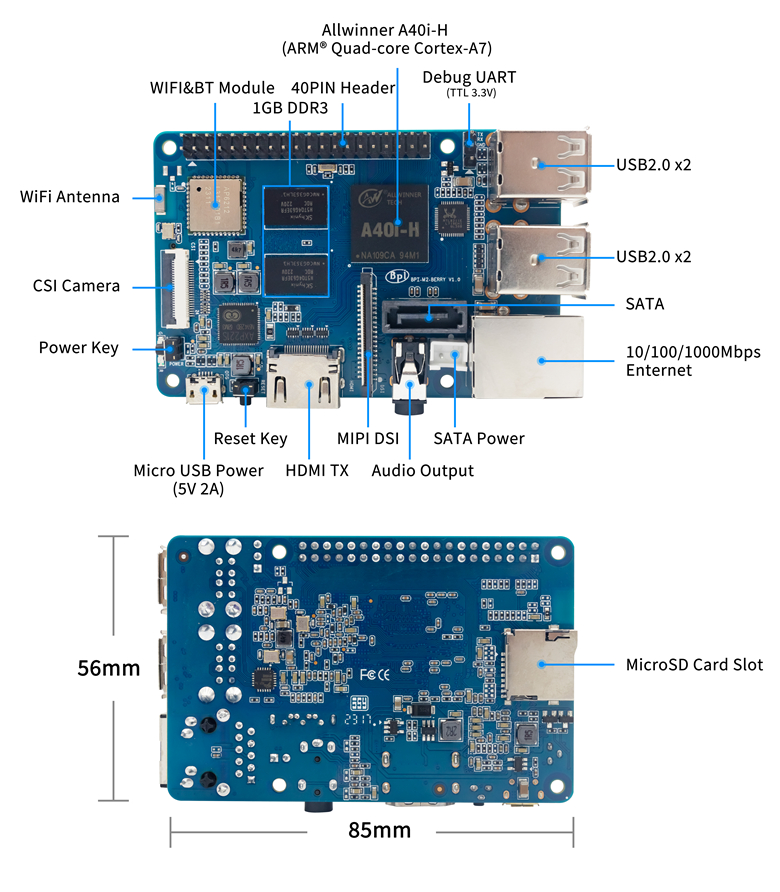I got a BPI-M2 Berry, wanting to use it with a 7-inch display and a Raspberry Pi case.
Some months ago, I had flashed 2020-04-19-raspbian-jessie-bpi-m2u-sd-emmc.img on an SD card, assembled the case, and tried to power it via the micro USB power port, from a USB adapter rated 5V / 2A; the backlight of the 7 inch display turned on, but nothing else happened; tried power down / up several times, same behavior.
Today I realized the case was permanently pressing the RESET button, as there was no opening for it; so I disassembled the case, and made an opening for the RESET button - and now the button is free, and can be pressed. So tried booting again by power it via the micro USB power port - nothing happens whatsoever.
Only after searching online, did I realize that there is supposed to be a red LED on the board - unfortunately, this LED is not listed on the https://wiki.banana-pi.org/images/c/ce/M2ubinterface.jpg image from the Banana Pi BPI-M2 Berry - Banana Pi Wiki page - and I only confirmed where it is and how it looks like after finding the video BananaPi-M2 Berry - YouTube.
So, now I can definitely say, that when I try to apply power via the micro USB power port from a 5V / 2A USB power adapter – both with SD card plugged in; and without SD card plugged in – absolutely nothing happens, no red LED shines, and no green LED either.
I tried plugging the micro USB power port of this board to a USB A connector on my Ubuntu laptop as well; something interesting happens here:
- If I plug the USB cable to laptop when the SD card is attached on the BPI-M2 Berry, nothing is reported by Linux
- If I plug the USB cable to laptop when the SD card is not attached on (removed from) the BPI-M2 Berry, then I get the following reported:
Dec 9 10:28:32 mylaptop kernel: [209898.538616] usb 2-1.2: new full-speed USB device number 90 using ehci-pci
Dec 9 10:28:33 mylaptop kernel: [209898.647646] usb 2-1.2: New USB device found, idVendor=1f3a, idProduct=efe8, bcdDevice= 2.b3
Dec 9 10:28:33 mylaptop kernel: [209898.647656] usb 2-1.2: New USB device strings: Mfr=0, Product=0, SerialNumber=0
Dec 9 10:28:33 mylaptop mtp-probe: checking bus 2, device 90: "/sys/devices/pci0000:00/0000:00:1d.0/usb2/2-1/2-1.2"
Dec 9 10:28:33 mylaptop mtp-probe: bus: 2, device: 90 was not an MTP device
Dec 9 10:28:33 mylaptop mtp-probe: checking bus 2, device 90: "/sys/devices/pci0000:00/0000:00:1d.0/usb2/2-1/2-1.2"
Dec 9 10:28:33 mylaptop mtp-probe: bus: 2, device: 90 was not an MTP device
Dec 9 10:28:33 mylaptop systemd-udevd[144342]: 2-1.2: Process '/usr/lib/snapd/snap-device-helper bind snap_cups_cupsd /devices/pci0000:00/0000:00:1d.0/usb2/2-1/2-1.2 189:217' failed with exit code 1.
Dec 9 10:28:33 mylaptop systemd-udevd[144342]: 2-1.2: Process '/usr/lib/snapd/snap-device-helper bind snap_cups_ippeveprinter /devices/pci0000:00/0000:00:1d.0/usb2/2-1/2-1.2 189:217' failed with exit code 1.
So, the micro USB power port of the BPI-M2 Berry, when no SD card is attached, appears to Linux as a USB device with vendor ID 0x1F3A, and product ID 0xEFE8 - via USB\VID_1F3A&PID_EFE8 - sunxi SoC OTG connector in… | Device Hunt I get that this is Allwinner Technology “sunxi SoC OTG connector in FEL/flashing mode”.
So this made me think - can I just power up the BPI-M2 Berry using a normal USB cable, or do I have to use a USB OTG cable? I ask because I found this post BPI won't start at all - #2 by hermann4 where someone asks for a different (BananaPi M2-U) board:
… but unfortunately no one clarifies whether USB-OTG is required in general.
Then, I also found this How to bypass power button? :
What, so I had to also press power to make it boot, after applying power? I did not see that mentioned in neither Banana Pi BPI-M2 Berry - Banana Pi Wiki nor Getting Started with M2 Ultra & Berry - Banana Pi Wiki ( Quick Start Banana pi SBC - Banana Pi Wiki only mentions "you can press the power key for 5 seconds to turn it off. " but I think that is for a different board? )
Anyways, tried plugging in the BPI-M2 Berry micro USB power port to a 5V / 2A adapter – both with and without SD card – then pressing and holding power button for 10 seconds, then releasing: absolutely nothing happens, and there is still no red LED.
So my question is - is this board fully dead, or can it be recovered?
Apparently something on it still works (as display does get backlight power, and can get the 1F3A:EFE8 device detected over USB) – so is there some debug procedure I could do, to confirm whether the board is really dead or not?
